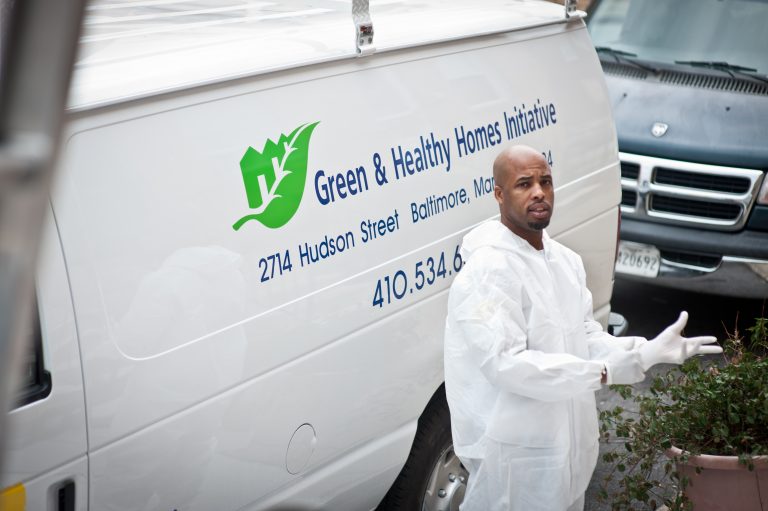Healthy and energy-efficient housing is critical for the wellness and prosperity of all our families, seniors and communities

Safe housing conditions are often the difference between good health and chronic disease, preventing household injuries, having the ability to build generational wealth and avoiding the perpetual cycle of poverty. That’s why each year the U.S. Department of Housing and Urban Development (HUD) and its federal partners designate the month of June as “National Healthy Homes Month.” And it’s why organizations like Green & Healthy Homes Initiative (GHHI) devote this month, and every month, to building awareness around home-based environmental health hazards and how residents can safely address hazards to make their homes healthier.
GHHI’s Commitment to Healthy Housing
Less than halfway through 2022, the urgency and pace of our work to eradicate the broad impacts of unhealthy and energy-inefficient housing—and the unjust policies that have resulted in increased generational disease and housing decline—continues at scale to bring improved health and equity outcomes to cities and states across the U.S. We’re tremendously proud to advise and partner with federal and local governments, utilities, community service providers, philanthropies and health care entities to spearhead meaningful policies, direct investments in housing repairs and the delivery of game-changing, integrated programs—all resulting in a 99% decline in childhood lead poisoning here in Maryland, and reduced asthma episodes and energy loss for clients in our partner sites. Some highlights include:
- In Pennsylvania, our team is working alongside the state’s largest health system to design, implement and plan the evaluation of a transformative $50 million investment by Penn Medicine Lancaster General Hospital in protecting children in Lancaster from lead poisoning.
- GHHI is partnering with managed care organizations In Maryland and North Carolina that are funding the provision of evidence-based healthy homes preventive services to reduce asthma episodes and injuries in the home.
- In January, we announced a partnership with the New York Healthy Homes Collaborative on a groundbreaking $4.75 million project that will address asthma and health equity for low-income children and adults in New York City who are enrolled in Medicaid with Affinity by Molina Healthcare. In addition to directly serving 850 New York residents with asthma, this project demonstrates a replicable model for using private-sector financing and Medicaid dollars to fund preventive services that directly address the social determinants of health.
- In May, we launched the Detroit Home Repair Fund in Detroit with an announcement of $20 million in funding for critical home repairs from the Gilbert Family Foundation, ProMedica and DTE Energy for 1,000 low-income homeowners as the first of seven ProMedica-GHHI project sites to commence interventions.
GHHI’s ongoing policy and on-the-ground efforts in Baltimore continue to center our work in providing home assessments, conducting home repairs to remediate hazards, building community awareness and providing other direct services to tenants and owners every day. Over the last five years alone, we’ve worked in the homes of more than 1,095 families to improve the safety of their homes and through this, their quality of life.
There is much progress to celebrate—and much more still to be accomplished—as awareness of the impacts of and solutions for healthy homes grows. We’re tremendously grateful for the commitment, passion and expertise of our incredible partners in this work and the communities we serve nationally.
National Healthy Homes Month
This year’s Healthy Homes Month theme, A Healthy Home @ Any Age, underscores the importance of eliminating lead hazards and asthma triggers and creating healthier and more energy-efficient housing that ensures every child gets to school healthy and ready to learn, and every senior ages in place with health and dignity.
Examples of the urgent need for this work are all around us: Poorly vented appliances that increase exposure to carbon monoxide in utero and impact fetal development or occupants’ cognitive abilities. Aging homes with mold, lead and safety hazards continue to cause serious mental and physical harm across generations. Poorly weatherized homes leave parents unable to afford utility bills or keep their families warm, affecting financial and housing stability. Older adults continue to sustain serious injuries from falls in homes with narrow stairs, doorways or other obstacles and tripping hazards
As I expressed in my testimony before the U.S. Senate Committee on Banking, Housing, and Urban Affairs a few weeks ago, safe and healthy housing conditions are a critical social determinant of health, especially in Black, Brown and low-income communities that historically have been denied access to health and housing resources. The heightened focus and funding for climate change mitigation provides a unique opportunity to use energy efficiency dollars to improve health by addressing extreme heat and cold and improving indoor air quality, among other benefits. Together, we must continue to address individual and community health and equity through safer housing with increased healthy homes intervention services, broader access to resources, more robust energy efficiency programs and funding, and continued workforce development for the next generation of “green workers” hired from under-resourced communities.
Thank You and Stay Tuned . . .
As we kick off National Healthy Homes Month this week, plans are underway to launch “1,000 homes” initiatives in six additional ProMedica-GHHI project cities this year, including Baltimore, Chicago, Cleveland, Philadelphia, Pittsburgh and Toledo. And later this month, we’re excited to announce the launch of new healthy homes programs and partnerships in North Carolina and New Jersey.
We thank HUD’s Office of Lead Hazard Control and Healthy Homes, the EPA, CDC, USDA and DOE for being such tremendous partners in helping to remediate hazards in the home and in leading the country forward towards improved health and energy outcomes.
I hope you’ll join us throughout June—and beyond—for a range of webinars and expert speakers, community events, resident stories and additional healthy homes resources for residents and communities. Stay tuned to the National Healthy Homes Month page on our website and follow us on social media for regular opportunities to learn more and get involved.